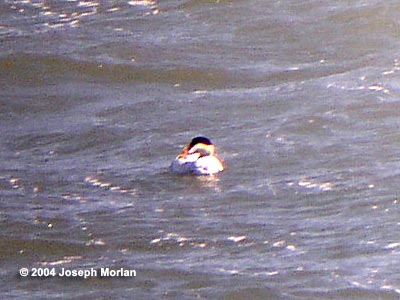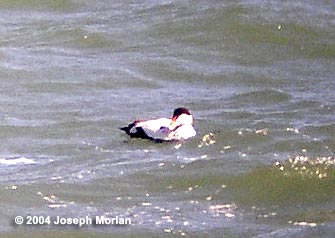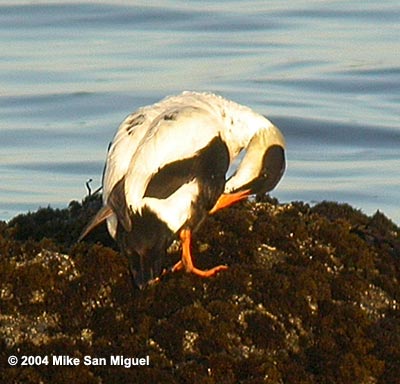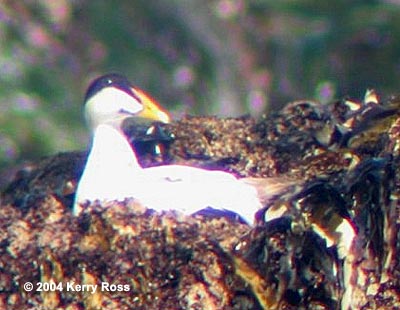Common Eider (Somateria
mollissima)
Crescent City, Pebble Beach, Del Norte County, California
7 July 2004
Joseph Morlan
Photos © 7 July 2004 by Joseph Morlan. All rights reserved.
 Robbie Fischer and
I drove up to Crescent City on 7 July 2004 hoping to see the Common Eider which had been found at the Battery Point
Lighthouse on 5 July by Chuck and Barbara Vaughn and photographed that evening by Ron LeValley. The next day it
was seen well in the morning by several people and photographed at close range by Kerry Ross & Mike San Miguel
(see below). However, the bird disappeared around 1pm in the afternoon and was not seen
for the rest of the day. The next morning, before we arrived, it was rediscovered on offshore rocks near Castle
Rock, but flew back towards Battery Point in the early afternoon.
Robbie Fischer and
I drove up to Crescent City on 7 July 2004 hoping to see the Common Eider which had been found at the Battery Point
Lighthouse on 5 July by Chuck and Barbara Vaughn and photographed that evening by Ron LeValley. The next day it
was seen well in the morning by several people and photographed at close range by Kerry Ross & Mike San Miguel
(see below). However, the bird disappeared around 1pm in the afternoon and was not seen
for the rest of the day. The next morning, before we arrived, it was rediscovered on offshore rocks near Castle
Rock, but flew back towards Battery Point in the early afternoon.
We arrived about 3:30pm and stopped at the foot of 5th Street. Almost immediately, I saw the Common Eider flying
to the north from Battery Point, in the direction of Castle Rock. I pointed out the bird to Robbie and we watched
it disappear behind a large rock to the north. We headed up to the area where the bird disappeared, looking from
several spots when Rich Stallcup drove up and told us he had located the bird a bit to the north. We followed him
in our car and arrived at a lookout along Pebble Beach Drive at the foot of Keller where Jim Lomax and Frances
Oliver had the bird under observation. It was fairly distant and associating loosely with two Surf Scoters. The
wind was quite strong, at one point blowing over my scope which, fortunately, was undamaged.
Rich and I set up scopes behind Frances Oliver's vehicle which sheltered us from the wind and I attempted to
digisco pe the bird with
the results here. I also took a few notes while watching the bird. The following is based on those notes, but also
on additional photos by Kerry Ross and Mike San Miguel (below).
pe the bird with
the results here. I also took a few notes while watching the bird. The following is based on those notes, but also
on additional photos by Kerry Ross and Mike San Miguel (below).
Description
The goose-sized sea duck was first seen in flight and was very distinctive. It was mostly white above with a
black belly and tail, and a distinct black cap. Viewing from above, the wing coverts were white, but the primaries
and secondaries were black. The wings appeared quite long and relatively pointed. The bird was a strong flier and
did not show any obvious signs of molt or missing flight feathers. The long, bright orange bill was also distinctive
and was easily seen in flight as the bird was below us.
The second observation through scopes of the bird in the water and diving occasionally, allowed observation
of a few more details. The bright orange bill was strongly lobed at the base, with the lateral maxillary lobes
extending high up toward the crown, separated by black feathers on the forehead and extending more than half way
down the bill.
The black cap was very well defined and curved just under the eye to the nape where it sharply contrasted with
the white face. The neck, and chest appeared all white connecting with the white back. A large dark belly patch
extended up the flanks, but long white tertials hung down over the flanks resulting in a white spur just anterior
to the black tail. While the bird was preening I was able to see, that the rump and underwings were white. I was
able to see that the legs and feet were the same bright orange coloration as the bill.
I could not convince myself that the color on nape had any green in it. It just looked faintly washed in buff,
possibly with an olive tinge. However some close-up photos show it to be tinged green. Close
photos also reveal a clean black "v-shaped" marking extending back from just under the chin.
We returned the next morning to the same area, but the eider was much further away. Dave Weber spotted it foraging
near an offshore rock. The light was better, but the extreme distance precluded seeing any more detail. The bird
seems to have settled in this area where most recent sightings have been. At this time, we were joined by a number
of other interested birders including Alan Barron.
Discussion
This is the first confirmed record of Common Eider for California. A female eider seen off Fort Point, San Francisco,
12 December 1982, was reported as a Common Eider, but published as an "apparent female King Eider" (Am.
Birds 37:333, 1983). It was not accepted by the California Bird Records Committee. There is also an old sight-record
off Bodega Head of a female seen in flight by Gordon Bolander who thought it was likely a Common Eider, but not
seen well enough, and never submitted as such.
The Common Eider occurs in two well-marked subspecies. S. m. dresseri in the Northeast and S. m. v-nigra
in Alaska. There are records of dresseri as far west as Nebraska and Wisconsin while v-nigra has
strayed to North Dakota, Minnesota, Iowa and Kansas. The species was previously unrecorded on the West Coast south
of British Columbia. This individual shows the characters of v-nigra, having a bright orange bill and a
black V on the throat.
Additional Photos
 |

Both of these photos were taken early on 6 July. All rights reserved |
Additional photos by Kerry Ross are here and photos by
Ron LeValley are here. A video by Leslie Lieurance is
here.
 Robbie Fischer and
I drove up to Crescent City on 7 July 2004 hoping to see the Common Eider which had been found at the Battery Point
Lighthouse on 5 July by Chuck and Barbara Vaughn and photographed that evening by Ron LeValley. The next day it
was seen well in the morning by several people and photographed at close range by Kerry Ross & Mike San Miguel
(see below). However, the bird disappeared around 1pm in the afternoon and was not seen
for the rest of the day. The next morning, before we arrived, it was rediscovered on offshore rocks near Castle
Rock, but flew back towards Battery Point in the early afternoon.
Robbie Fischer and
I drove up to Crescent City on 7 July 2004 hoping to see the Common Eider which had been found at the Battery Point
Lighthouse on 5 July by Chuck and Barbara Vaughn and photographed that evening by Ron LeValley. The next day it
was seen well in the morning by several people and photographed at close range by Kerry Ross & Mike San Miguel
(see below). However, the bird disappeared around 1pm in the afternoon and was not seen
for the rest of the day. The next morning, before we arrived, it was rediscovered on offshore rocks near Castle
Rock, but flew back towards Battery Point in the early afternoon. pe the bird with
the results here. I also took a few notes while watching the bird. The following is based on those notes, but also
on additional photos by Kerry Ross and Mike San Miguel (
pe the bird with
the results here. I also took a few notes while watching the bird. The following is based on those notes, but also
on additional photos by Kerry Ross and Mike San Miguel (
